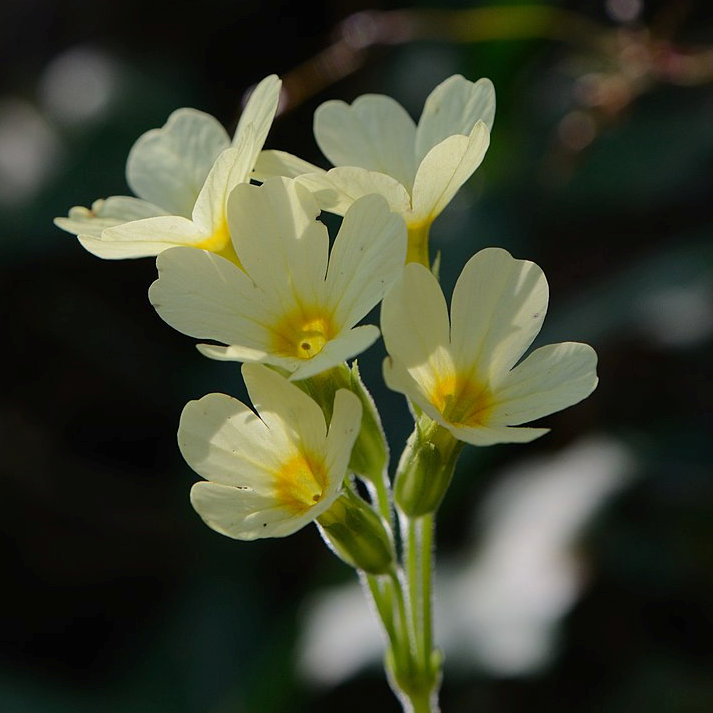Closely related to the primrose (P. vulgaris) and cowslip (P. veris), the true oxlip is native in a few woodland locations in the East of England and Buckinghamshire1. . It is widely distributed elsewhere in Europe and Western Asia.
It bears rounded leaves rather like those of the cowslip, and bunched flowers of a pale yellow colour similar to the colour of the primrose, but smaller and more delicate. It prefers to grow in the dappled shade of deciduous woodlands. It is distinct from the natural hybrids between primroses and cowslips which sometimes occur when those two species grow together; those hybrids are conventionally labelled ‘False Oxlips’ and tend to resemble the closely related ‘polyanthus’ hybrids of gardens, with larger flowers and coarser leaves.
In Shakespeare’s Midsummer Night’s Dream Oberon says:
“I know a bank where the wild thyme blows, |
Where oxlips and the nodding violet grows, |
Quite over-canopied with luscious woodbine, |
With sweet musk-roses and with eglantine:” |
This ‘oxlip’ was not a reference to P. elatior however, but to the coarser hybrid between primroses and cowslips. The true oxlip Primula elatior was first described in Britain by John Ray in 16603. , but not definitely accepted by botanists as the true species until the 1840s, when Henry Doubleday observed the oxlip growing in quantity around Great Bardfield in Essex, still one of its haunts today, and noted that it could not be a hybrid because its putative parents did not grow in the locality3. .
It attracts bee flies (Bombylius species), and is eaten by a few moths including the double square-spot Xestia triangulum4. .
It is easily grown in gardens in a humus-rich soil in dappled shade, in the same sort of conditions in which primroses thrive. As it will readily hybridise with other Primula species nearby, any self-sown seedlings need to be observed to make sure they are true to type.
References
1. Stace, C. 2010. New Flora of the British Isles, Third Edition. P. 517.
2. Pearman, D. (2017). The Discovery of the Native Flora of Britain and Ireland, Botanical Society of Britain & Ireland. P. 324
3. Mabey, R. 1996. Flora Britannica. P. 168-169.
4. See the Biological Record Centre database
Page written by Marc Carlton. Compiled by Steve Head
Oxlip Primula elatior
Family – Primulaceae, Primrose family
Herbaceous perennial – up to 30cm tall, forming a clump.
Flowering – April to May
Soils - Neutral to alkaline
Position – Partial shade.


Oxlip Primula elatior
Herbaceous perennial – up to 30cm tall, forming a clump.
Flowering – April to May
Soils - Neutral to alkaline
Position – Partial shade.
Closely related to the primrose (P. vulgaris) and cowslip (P. veris), the true oxlip is native in a few woodland locations in the East of England and Buckinghamshire1. . It is widely distributed elsewhere in Europe and Western Asia.
It bears rounded leaves rather like those of the cowslip, and bunched flowers of a pale yellow colour similar to the colour of the primrose, but smaller and more delicate. It prefers to grow in the dappled shade of deciduous woodlands. It is distinct from the natural hybrids between primroses and cowslips which sometimes occur when those two species grow together; those hybrids are conventionally labelled ‘False Oxlips’ and tend to resemble the closely related ‘polyanthus’ hybrids of gardens, with larger flowers and coarser leaves.
In Shakespeare’s Midsummer Night’s Dream Oberon says:
“I know a bank where the wild thyme blows, |
Where oxlips and the nodding violet grows, |
Quite over-canopied with luscious woodbine, |
With sweet musk-roses and with eglantine:” |
This ‘oxlip’ was not a reference to P. elatior however, but to the coarser hybrid between primroses and cowslips. The true oxlip Primula elatior was first described in Britain by John Ray in 16603. , but not definitely accepted by botanists as the true species until the 1840s, when Henry Doubleday observed the oxlip growing in quantity around Great Bardfield in Essex, still one of its haunts today, and noted that it could not be a hybrid because its putative parents did not grow in the locality3. .
It attracts bee flies (Bombylius species), and is eaten by a few moths including the double square-spot Xestia triangulum4. .
It is easily grown in gardens in a humus-rich soil in dappled shade, in the same sort of conditions in which primroses thrive. As it will readily hybridise with other Primula species nearby, any self-sown seedlings need to be observed to make sure they are true to type.
References
1. Stace, C. 2010. New Flora of the British Isles, Third Edition. P. 517.
2. Pearman, D. (2017). The Discovery of the Native Flora of Britain and Ireland, Botanical Society of Britain & Ireland. P. 324
3. Mabey, R. 1996. Flora Britannica. P. 168-169.
4. See the Biological Record Centre database
Page written by Marc Carlton. Compiled by Steve Head






